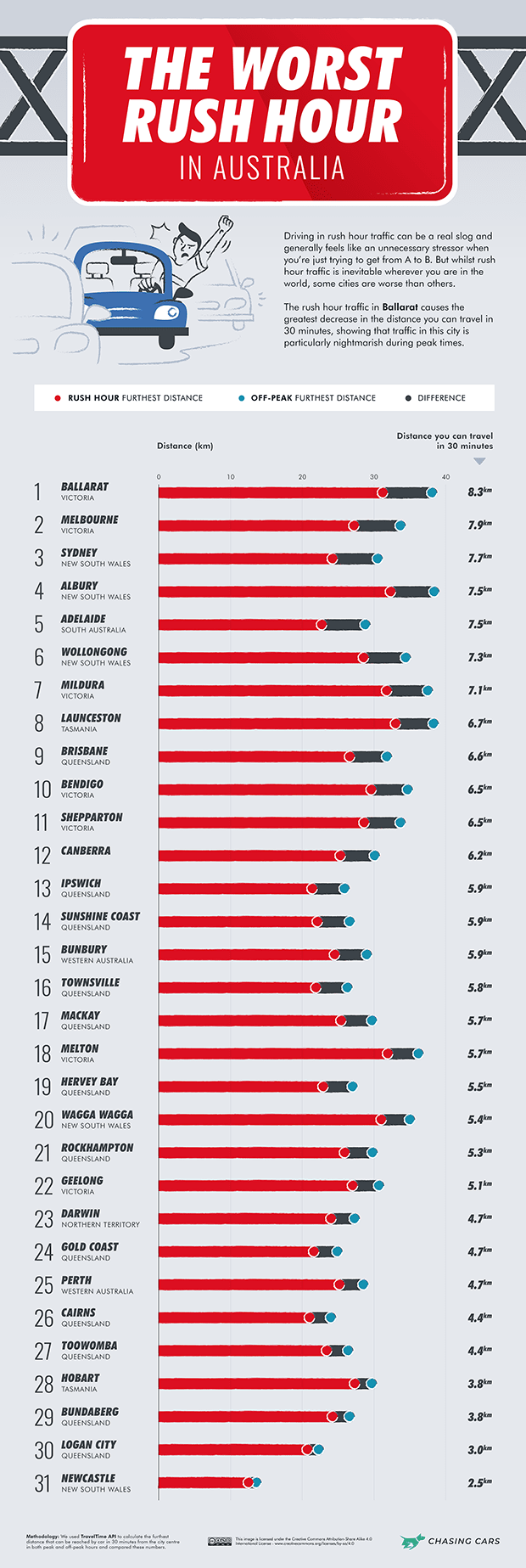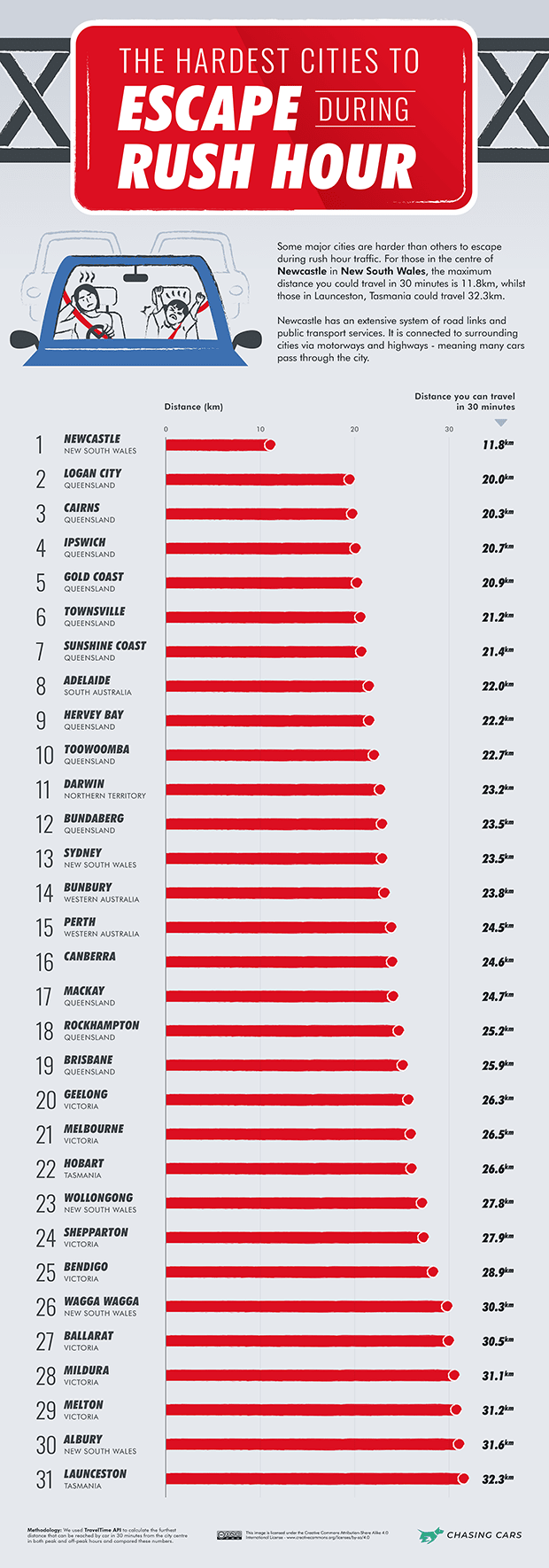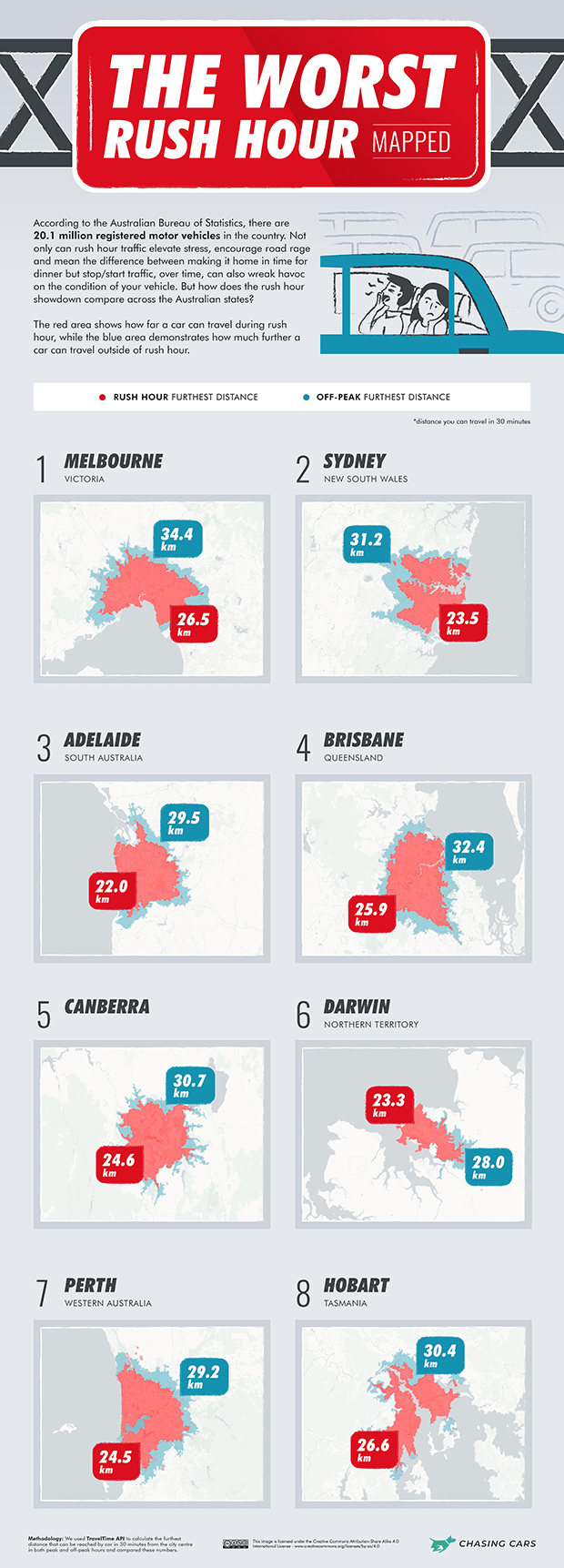-
Car Reviews
- All reviews
- Midsize SUVs
- Small cars
- Utes
- Small SUVs
- Large SUVs
- Large cars
- Sports SUVs
- Sports cars
- Vans
Latest reviews
- Car News
-
Car Comparisons
Latest comparisons
- Chasing Deals
The traffic jam is alive and well in Australia.
Rush hour traffic wavered a little during the height of the pandemic, when congestion of major Melbourne roads fell from a healthy 19.8 percent to a ‘Sunday drive’-like 1.8 percent. But road traffic has recovered like no other form of transport, and Australia’s highways are good and clogged again.
Despite the work-from-home revolution, Covid-19 did not kill the rush hour. If anything, the rush hour has evolved a deadly new strain as we settle into new patterns of work, commerce, and leisure. As road usage continues to grow, it will lead to congestion, pollution, noise and accidents.
But which areas of Australia are hit the worst? Chasing Cars used TravelTime API to find the furthest distance you can travel from the centre of Australia’s biggest cities during peak and off-peak times, and compared the figures to find which cities’ roads grab the tightest.
Our first chart demonstrates the difference between how far from the city centre you can drive in peak and off-peak times in 30 minutes.
Australia’s most dramatic rush hour is in Ballarat, where you can get 38.8km from town in 30 minutes of light traffic, but just 30.5km in rush hour – a delay of 8.3km. In addition to these usual delays, Victoria’s third-largest city has braved repeated lockdowns, with short-notice announcements causing sudden, dense tailbacks.
Victoria is home to four of Australia’s worst cities for rush-hour traffic. Melbourne is second-worst, with Mildura and Bendigo not far behind. Even though an increasing proportion of Melburnians use public transport, driver numbers are rising too. Between 2013-18, there was an increase of 110,000 people using only a car to get to work. Today, you can travel 34.4km from Melbourne’s city centre in quiet times, but only 26.5km in 30 minutes of rush hour driving.
We’ve seen the worst cities for difference between peak and off-peak times. But what are the worst cities in absolute terms? Well, Newcastle in New South Wales is the hardest city to escape. Thirty minutes of rush hour driving will take you just 11.8km from the city centre. An average of 23.6km/h.
But, city for city, Queensland has the toughest commute. Eight of the top 10 longest commutes are from cities in the Sunshine State. Queensland’s capital, Brisbane, actually enjoyed a 15 percent rise in bicycle usage during the pandemic, but public transport usage dropped by 40 percent. Today, traffic levels are worse than ever as commuters resist a return to public transport.
Finally, here’s a visualization of how far you can get from the centre of each state capital in peak and off-peak times. South Australia’s Adelaide has the tightest squeeze: you’ll drive just 22km from the centre in 30 rush hour minutes.
But Melbourne, Victoria, is the capital that experiences the most significant disparity between rush hour and the church-run: a 7.9km setback. Hobart, capital of Tasmania, is the easiest capital to escape, both in absolute terms (you can drive 26.6km in 30 peak minutes) and relative to off-peak times (rush hour subtracts just 3.8km from a 30-minute journey).
The most significant way you can worsen traffic is to get out in your car and drive. But when driving is a must, consider that driving considerately and within the rules lessens your impact on the rush hour clog.
In fact, the best way to defeat traffic is to get rid of human drivers altogether. Roll on self-driving cars?
We compiled a list of cities in Australia and selected ones with a population of more than 50,000.
We used TravelTime API to calculate the furthest distance that can be reached by car in 30 minutes from the city centre in both peak and off-peak hours and compared these numbers.
Data collected August 2021.
Latest news
About Chasing cars
Chasing Cars reviews are 100% independent.
Because we are powered by Budget Direct Insurance, we don’t receive advertising or sales revenue from car manufacturers.
We’re truly independent – giving you Australia’s best car reviews.


